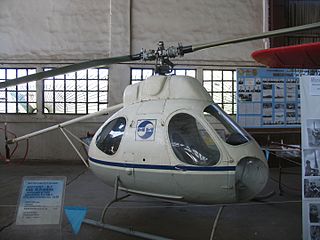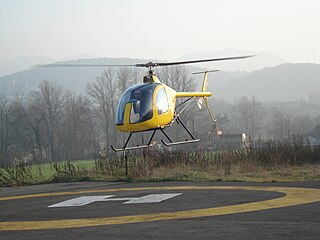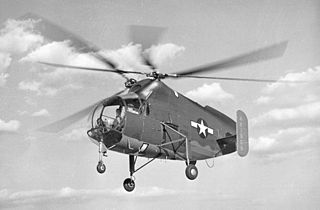Related Research Articles

The Bensen B-8 is a small, single-seat autogyro developed in the United States in the 1950s. Although the original manufacturer stopped production in 1987, plans for homebuilders are still available as of 2019. Its design was a refinement of the Bensen B-7, and like that aircraft, the B-8 was initially built as an unpowered rotor-kite. It first flew in this form in 1955, and on 6 December a powered version, designated B-8M first flew. The design proved to be extremely popular and long-lasting, with thousands of sets of plans sold over the next thirty years.

The Hughes XH-17 "Flying Crane" was the first helicopter project for the helicopter division of Hughes Aircraft Company. The XH-17, which had a two-bladed main rotor system with a diameter of 134 feet, still holds the world record for flying with the largest rotor system. It was capable of flying at a gross weight of more than 50,000 pounds (23,000 kg), but proved too inefficient and cumbersome to be mass-produced beyond the prototype unit.

The Aerotécnica AC-12Pepo is a Spanish two-seat light helicopter manufactured in 1956 by Aerotécnica.

The Agusta A.101 was a large prototype transport helicopter developed in Italy during the 1960s. Despite prospective orders from the Italian armed forces, no buyers emerged and the project was abandoned in 1971.

The Agusta A.103 was an Italian prototype single-seat light helicopter flown in October 1959. The pilot was enclosed by a perspex bubble with the engine at the rear and the tail rotor carried on an enclosed boom.

The Agusta A.104 Helicar was an Italian prototype light commercial helicopter first flown in December 1960.

The Agusta A.106 was a single-seat light helicopter designed to provide an anti-submarine warfare (ASW) platform for the Impavido-class destroyers of the Italian Navy. The aircraft was provided with a sophisticated electronics suite by Ferranti for autostabilisation and contact identification. Two torpedoes could be slung under the fuselage. The tail and two-bladed main rotor could be folded for shipboard stowage, and the skid undercarriage had fittings for flotation bags.

The Seibel S-4 was a two-bladed, single-engine helicopter built by Seibel Helicopter. Designed by Charles Seibel, the S-4 was evaluated by the United States Army under the designation YH-24 Sky Hawk, but would be rejected for service. The S-4B would serve as the basis for the design of the Cessna CH-1 Skyhook, the only helicopter Cessna ever produced.

The Bölkow Bo 103 was a small experimental helicopter flown in West Germany in 1961 to research new rotor systems. While the mechanics of the aircraft were based on the Bo 102 captive training rig, the Bo 103 was capable of fully independent flight. In configuration, it was absolutely minimalist - consisting of nothing more than a tubular frame to which the dynamic components and the pilots seat were attached, although a small fibreglass cabin was eventually attached. The aircraft retained the Bo 102's single-rotor of Glass-reinforced plastic, and proved that this was suitable for true flight. The prototype is preserved at the Hubschraubermuseum Bückeburg.

The Hughes XV-9 was a 1960s American high-speed research helicopter built by Hughes Helicopters.

The Doman LZ-5 was a utility helicopter developed in the United States in the early 1950s by Doman Helicopters Inc. of Danbury, Connecticut. Despite the procurement of international manufacturing agreements, no series production of the aircraft ever occurred and only three prototypes were built. Two of these were purchased by the United States Army as the YH-31, but eventually becoming VH-31.

The Cierva CR Twin was a five-seat utility helicopter that first flew in the UK in 1969. It was a joint development between Cierva Autogiro Company and Rotorcraft now a subsidiary of Cierva, based on the dynamic systems of the latter company's Grasshopper design. A new, highly streamlined pod-and-boom fuselage was married to the Grasshopper's coaxial rotor system, and the new aircraft registered G-AWRP first flew on 18 August 1969.

The Mil V-7 was an unusual experimental four-seat helicopter with AI-7 ramjets at the tips of the two rotor blades. It had an egg-shaped fuselage, skid undercarriage, and a two-bladed tail rotor on a short tubular tail boom. Four aircraft were built in the late 1950s, but only one is known to have flown, with only the pilot aboard.
The Kamov Ka-126 is a Soviet light utility helicopter with co-axial rotors. Evolved from Ka-26 with engine pods removed from stub wings, fitted with one TVO-100 turboshaft engine positioned on top of fuselage, modified rotor blades, new fuel system.

The DF Helicopters DF334 is a two-seat, single-engine light utility helicopter in development by Dragon Fly Helicopters in Northern Italy. The DF 334 is a development of the Dragon Fly 333, developed by archaeologists and filmmakers Angelo and Alfredo Castiglioni in the 1980s. The DF334 has a larger, full composite cabin, a Rotax 914 4-stroke turbocharged engine, a governor fuel control, and an advanced Electronic Flight Instrument System. The helicopter is intended for both amateur and professional pilots.
The Bensen Mid-Jet was a small helicopter developed by Igor Bensen in the United States in the early 1950s in the hope of attracting the interest of the United States Navy. It was a single-seat, open framework machine based on the B-5 rotor kite with small, gasoline- or fuel oil-burning ramjets mounted as tipjets on the rotor blades. Tests carried out in 1954 showed it to be able to lift four times its own weight and cruise at 75 mph (120 km/h).

The Kawasaki KH-4 was a light utility helicopter produced in Japan in the 1960s as a development of the Bell 47 that Kawasaki had been building under licence since 1952. The most visible difference between the KH-4 and its forerunner was its new and enlarged cabin. This was fully enclosed and provided seating for three passengers side-by-side on a bench seat behind the pilot's seat. The helicopter was provided with a new control system, revised instrumentation, and larger fuel tank.

The Kellett XR-8 was a helicopter built in the United States during World War II. It was a two-seat machine intended to demonstrate the feasibility of a twin-rotor system, and while it accomplished this, it also demonstrated a number of problems that prevented further development of this particular design.

The Kellett XR-10 was a military transport helicopter developed in the United States in the 1940s that only flew in prototype form. It was designed in response to a USAAF Technical Instruction issued for the development of a helicopter to transport passengers, cargo, or wounded personnel within an enclosed fuselage. Kellett's proposal followed the general layout that the company was developing in the XR-8, with twin intermeshing rotors, and was accepted by the Air Force on 16 October over proposals by Sikorsky, Bell, and Platt-LePage.
The Dragon Fly 333 is an ultralight utility helicopter developed by archaeologists and filmmakers Angelo and Alfredo Castiglioni in the 1990s. French UAV manufacturer CAC Systèmes created a drone version named the Héliot for use in reconnaissance and as an aerial target, but the aircraft did not enter production.
References
- Bensen Aircraft Foundation
- Vortech page on B-9
- Simpson, R. W. (1998). Airlife's Helicopters and Rotorcraft. Ramsbury: Airlife Publishing. p. 210.